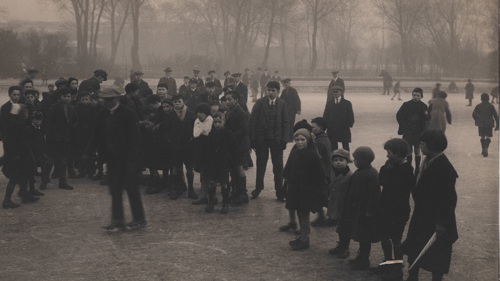Victoria Park - Times Past

Victoria Park has long been my favourite green space in Glasgow. Gloriously colourful flowers. Rock-walled walks. An ancient forest. It’s a park of many parts, quiet and secluded in places but in others full of life and laughter.
The land for the park was originally part of Scotstoun Estate. Forty-six acres were feued from J. Gordon Oswald to the Burgh of Partick in 1886. Work on laying out Victoria Park began in November of that year and was largely undertaken by unemployed shipyard workers in the area who created carriage drives, walks and ponds.
Named for Queen Victoria, the park was formally opened by Sir Andrew MacLean (Provost of Partick) in the summer of the monarch’s Golden Jubilee year (1887). Visitors to the park enjoyed bowling, tennis, cricket, football, putting, model yachting and paddle boating. In the winter, the larger pond was also used for skating once it had iced over. During the warmer months, there was a lively music scene with concert party and band performances providing the soundtrack for park life.
The most astounding feature of Victoria Park is undoubtedly the Fossil Grove: eleven fossilised tree stumps complete with partial trunks and roots. They grew over 330 million years ago and were preserved in their original growth position by the flooding of the local area and the settlement of sand in their hollow trunks. They were discovered in 1887 when workmen attempted to cut a walk through the layer of sandstone and shale at the bottom of an old quarry on the site. After the discovery, the site was excavated and the decision taken to leave them in situ beneath a specially designed Fossil House. Fossil Grove later became one of the most popular tourist attractions in Edwardian Glasgow.
Interestingly, Fossil Grove wasn’t the first prehistoric site to be uncovered in the area of the former quarry. In the layer above it, a Middle Bronze Age cist cemetery was discovered and several important finds made including a small polished and ornamented stone hammer.
Over time, the park has changed, gaining more land in 1894 and 1909 and losing some during the early 1960s when the approach roads to the Clyde Tunnel were being built. However, many of the earlier features remain including the clock gifted by J. Gordon Oswald and the 1922 war memorial for the men of Partick and Whiteinch. The beautifully painted red and gold main entrance gates made by Walter Macfarlane & Co. and commemorating Queen Victoria’s Golden Jubilee also still stand though in a different location to their original position. Gifted by the ladies of Partick and bearing that burgh’s coat of arms, they originally stood at the main entrance in Balshagray Avenue but were relocated to Victoria Park Drive North during the road building in that area.
Victoria Park and the Fossil Grove feature in several of our archive collections including the Burgh of Partick papers and the Glasgow Corporation Parks Department which has a beautiful series of photographs featuring different areas of this outstanding park.
